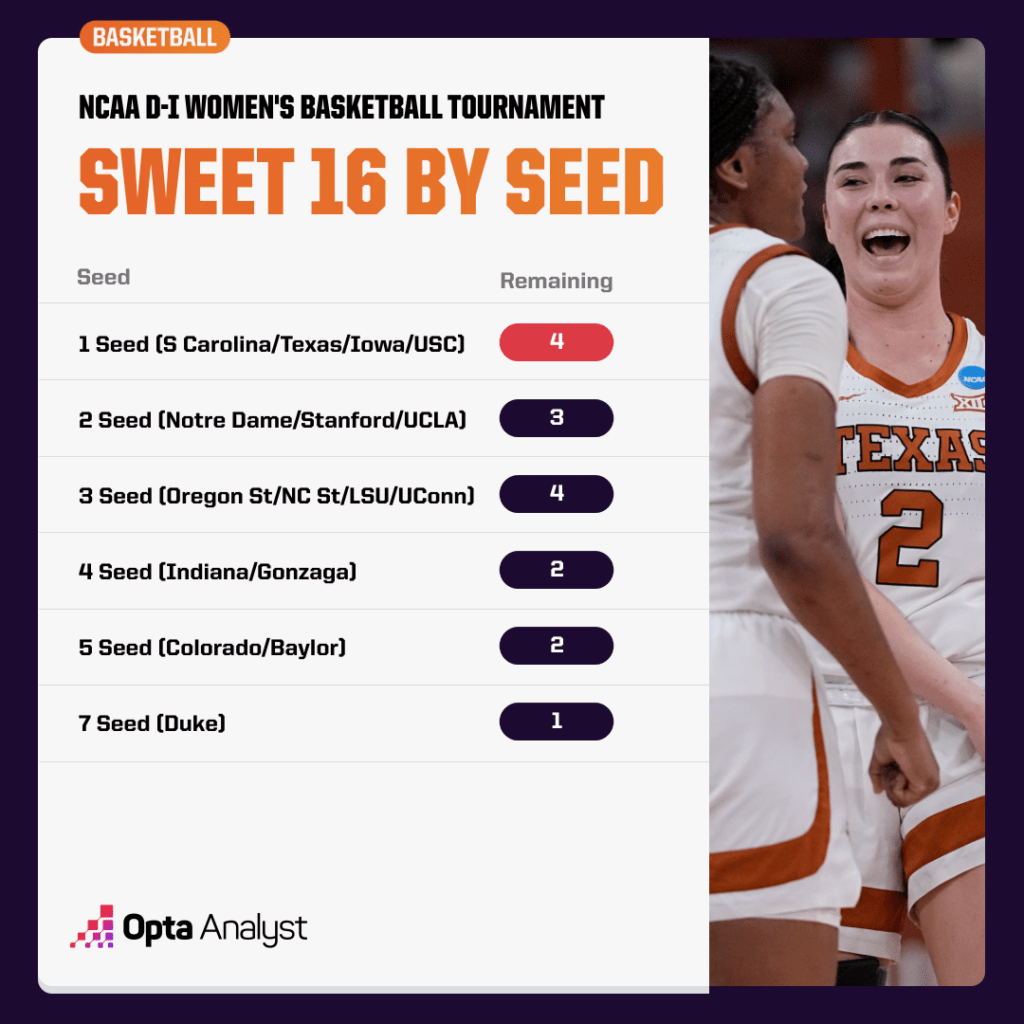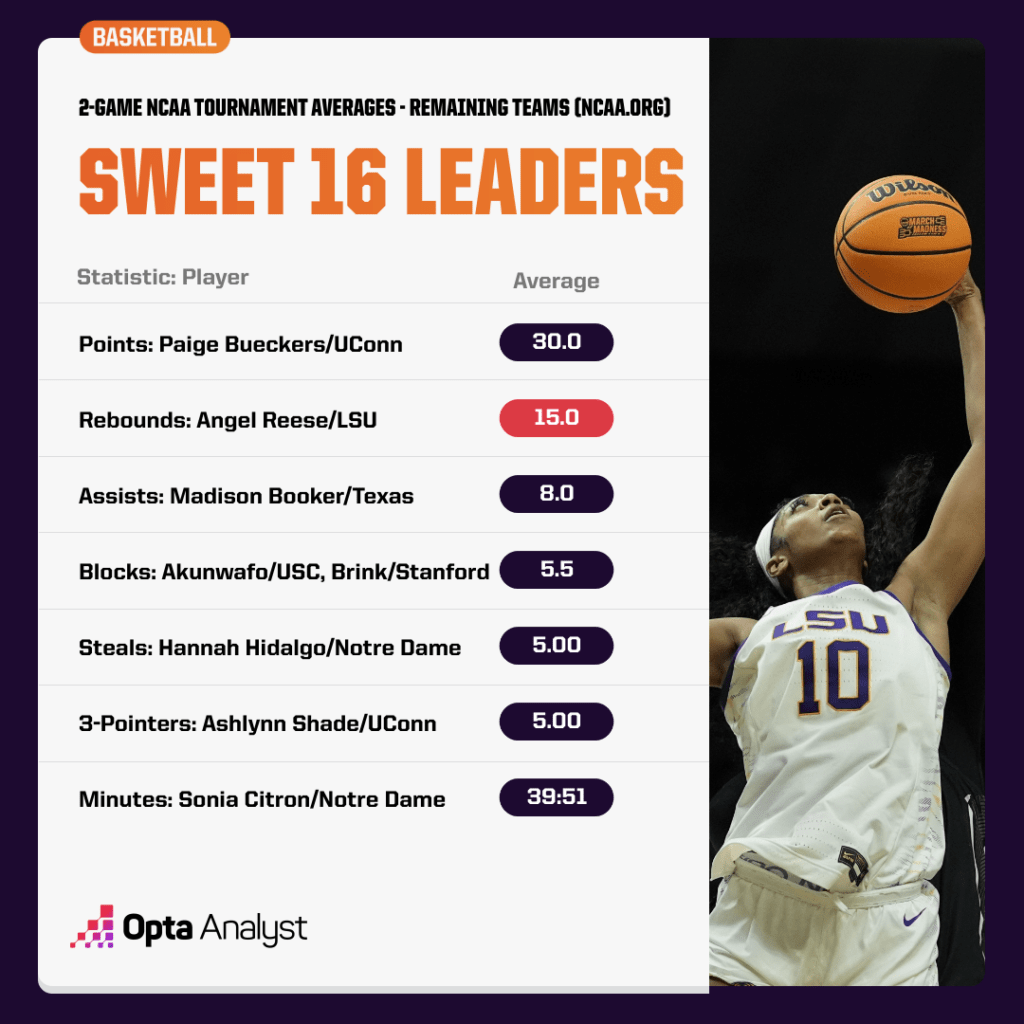With the help of our TRACR model, we’ve calculated the probabilities of advancement during March Madness. So if you’re looking for women’s Sweet 16 predictions, you’re in the right place.
Here’s an easy guess: Your men’s NCAA Tournament bracket is not doing too well.
How about your women’s bracket, though? If you went all chalk in your predictions, you would be in great shape.
Or if you used TRACR, our Team Rating Adjusted for Conference Roster, to make your picks, then you might be doing even better than an all-chalk bracket. TRACR is a net efficiency metric that calculates a team’s points per possession on both sides of the ball, adjusted by the team it plays. The model rewards teams that do well against good teams and subtracts from those that do poorly against weaker squads.
TRACR is excellent with women’s basketball projections – it correctly predicted 23 of the 32 Division I conference tournament winners earlier this month. It has done just as well in the NCAA Tournament – 14 of the Sweet 16 teams are ranked in TRACR’s top 16 (plus, Oregon State is 17th and Duke 19th).
The women’s NCAA Tournament typically has fewer upsets than the men’s version. In fact, only one team with a 1, 2 or 3 seed has ever lost in the Round of 64 (top-seeded Stanford in 1998). This year, however, you might as well have filled your bracket out with chalk.
After excluding the First Four games – when the matched teams have the same seeds – 44 of the 48 first- and second-round games ended with the better seed advancing with a win. That 91.7% is on pace to be the highest percentage in March Madness tournament history – men’s or women’s. For perspective, the better seed typically wins about 78% of the time in the women’s tournament and 70.7% with the men. (If only you had known this before picking too many women’s upsets.)

While there is a chance the women’s tournament remains chalky, TRACR indicates there should be more chaos among Sweet 16 predictions (Friday and Saturday) followed by the Elite Eight (Sunday and Monday).
Expected No. 1 Seeds Reaching the Final Four, Per TRACR
- At least one: 90.1%
- At least two: 54.8%
- At least three: 16.3%
- All four: 1.2%
Four times, the women’s NCAA Tournament has had a Final Four with only No. 1 seeds, most recently in 2018. That TRACR is predicting a low probability suggests it won’t happen again this year.
South Carolina, Iowa: Top No. 1 Seeds in Sweet 16
A continuing question with this year’s March Madness has revolved around predicting South Carolina as the champion or going with the rest of the field. TRACR says take coach Dawn Staley’s unbeaten Gamecocks (first), but just barely – while the supercomputer gives them a 78.5% chance of advancing out of the Albany 1 region and back to the Final Four, it’s indicating only a 51.9% chance to win the national title.
Iowa (fourth), playing in Albany 2, is the second-most likely No. 1 seed to reach the Final Four, but with a much lower chance than South Carolina – 47.2%. In the second round, the Hawkeyes fought off pesky West Virginia (20th) for a 64-54 victory, but they were far from perfect with 15 turnovers and 5-of-22 3-point shooting.
NCAA all-time scoring leader Caitlin Clark sank all five of the team’s 3s, and Iowa attempted 25 more free throws, going 25 of 30 overall. West Virginia has the fourth-best defense in Division I women’s basketball, so perhaps that slowed down a Hawkeyes offense that averages a national-high 92.0 points.
When making Sweet 16 predictions, consider Iowa will face a better offensive team than West Virginia in Colorado (12th). The Buffs have wins over 2023 women’s national champion LSU (sixth), Stanford (fifth) and USC (ninth) this season. Still, Iowa has a 75.8% chance of winning the game, per TRACR.
Will the 3 Seed Reign in Portland 3 Region?
Connecticut (second), the 11-time women’s champion whose last title was in 2016, is the main team that could stop March Madness from having only No. 1 seeds in the Final Four.
The No. 3-seeded Huskies needed a great outing from Paige Bueckers (P.B. with the J!) to get past Syracuse 72-64 in the second round, as she finished with 32 points, 10 rebounds, six assists and four steals. It marked just their second game not decided by double digits out of 36 overall games this season.

Still, TRACR likes UConn to emerge out of the Portland 3 region. Duke, the Huskies’ Sweet 16 opponent and a 7 seed, has a better defense than Syracuse, but it’s the lowest-rated team remaining, per TRACR, so the Huskies have an 83.6% chance of making it to the Elite Eight (also a 63.8% chance to reach the Final Four).
If your women’s Sweet 16 predictions have a No. 1 seed losing in Portland 3, it would be USC. It’s not that TRACR doesn’t like the Trojans – after all, they won the Pac-12 Tournament and have cruised to two NCAA Tournament wins thanks to strong starts and strong finishes.
It’s more Baylor (11th) is simply a tough matchup for USC. The Bears won on the road against Virginia Tech (15th) in the second round in what’s been one of the best games of the tournament. The X-factor was Jada Walker scoring a career-high 28 points in the win.
While USC relies on freshman phenom JuJu Watkins as its main scorer, Baylor has multiple weapons with experience.
TRACR favors Baylor, but barely with a 52.1% chance to advance in what it expects to be the closest Sweet 16 game.
Texas, Stanford Traveling on Collision Course?
While TRACR likes Texas (third) to win the Portland 4 region, the Longhorns may have an issue with facing Stanford in a possible Elite Eight matchup.
Texas demolished Drexel (164th) in its March Madness opener and won comfortably over Alabama (33rd) in the second round. The Longhorns are getting widespread production, but Aaliyah Moore (tourney averages of 15.5 points and 7.0 rebounds) and Madison Booker (14.5 points and 8.0 assists) have been tremendous.
Opta Analyst’s Sweet 16 Projections (Win Probability)
- No. 1 South Carolina over No. 4 Indiana (89.4%)
- No. 2 Notre Dame over No. 3 Oregon State (66.5%)
- No. 1 Iowa over No. 5 Colorado (75.8%)
- No. 3 LSU over No. 2 UCLA (54.9%)
- No. 1 Texas over No. 4 Gonzaga (73.1%)
- No. 2 Stanford over No. 3 NC State (56.7%)
- No. 5 Baylor over No. 1 USC (52.1%)
- No. 3 UConn over No. 7 Duke (83.6%)
The concern with Texas is 3-pointers. It shoots 36.5% from beyond the arc, but averages only 10.8 3-point attempts – the second-fewest in Division I to Little Rock’s 10.6. The Longhorns, who focus on outrebounding opponents and cashing in down low, attempted only five 3s against Alabama.
Stanford might be even better than Texas down low and shoots more 3s. Perhaps the best example of the Cardinal’s interior strength came in an overtime win against Iowa State (35th) in the second round.
Iowa State’s Audi Crooks, a freshman center who could be the next big star in the state, dropped 40 points on 18-of-20 shooting in the team’s opener against Maryland, doing something only Bill Walton has done in an NCAA Tournament game.
But Stanford shut down Crooks, limiting her to 10 points on just 3 of 21 from the floor. Cardinal forward Kiki Iriafen had the game of her life instead, finishing with 41 points and 16 rebounds.
Iowa State was 12 of 19 from beyond the arc, with Emily Ryan torching the Cardinal for 36 points and six 3s. If Texas doesn’t have a player step up to connect from beyond the arc, it could lose to Stanford’s interior defense.
First up for Texas is Gonzaga (10th) in the Sweet 16, and TRACR favors the Longhorns in Portland 4 with a 46.7% chance to make it to the Final Four. Stanford has the tougher Sweet 16 game against NC State (13th), but a win over the Wolfpack could lead to an excellent Elite Eight game between the top two seeds in the region.
No matter what happens over the next two rounds, the four teams still standing late Monday will advance to the Final Four, April 5-7 in Cleveland.
Make sure to stay up to date with our live March Madness predictions for both the men’s and women’s basketball tournaments.
Enjoy this? Check out our MLB, NBA and NFL coverage, and follow along on X and Instagram for more.
